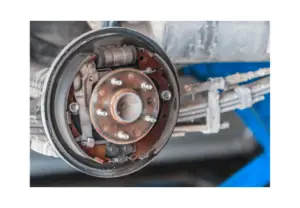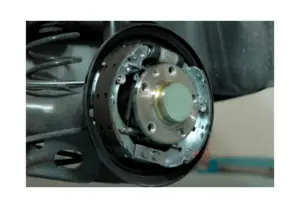Drum brakes are a type of brake system that’s been used in automobiles for many years. They work by using friction created by a set of shoes or pads that press outward against a rotating cylinder-shaped part called a drum. When the brake pedal is applied, hydraulic pressure forces the shoes against the drum, slowing or stopping the vehicle.
Over time and with use, the shoes will wear down, increasing the gap between the shoes and the drum. This leads to a longer distance for the shoes to travel when the brake pedal is applied, resulting in decreased braking efficiency.
Proper brake adjustment ensures the shoes are at an optimal distance from the drum, providing consistent and effective stopping power. Therefore, understanding how do drum brakes self-adjust, whether they manually adjust them or automatically, is an important part of vehicle maintenance.
Jump To
- 1 Overview of Self-Adjusting Drum Brakes
- 2 The Mechanism of Self-Adjusting Rear Drum Brakes
- 3 The Process of How Do Drum Brakes Self-Adjust
- 4 Importance of Self-Adjustable Brakes
- 5 Maintenance of Self-Adjustable Rear Drum Brakes
- 6 Differences Between Manual and Self-Adjustable Brakes
- 7 FAQs about Self-Adjusting Drum Brakes
Overview of Self-Adjusting Drum Brakes

Self-adjustable rear brakes are an evolution of the traditional drum brake design that automatically compensates for drum brake shoe wear. They function similarly to standard drum brakes, but with an added mechanism that adjusts the drums and shoes’ position as they wear down. This self-adjusting mechanism typically involves a lever and a ratchet assembly that progressively moves the shoes closer to the brake drums, maintaining optimal stopping efficiency.
The need for automatic drum brake adjustment arises from the wear and tear that shoes undergo over time. As the friction material on the shoes wears away, the distance between the shoes and the drum increases, which can reduce the brake’s effectiveness.
As drum brake shoes wear is gradual and often goes unnoticed by drivers until the stopping performance significantly deteriorates. Self-adjustable brakes on the front tires and the rear wheels counteract this issue by automatically maintaining the optimal distance between the shoes and brake drum, enhancing safety, and reducing the need for manual adjustments.
The Mechanism of Self-Adjusting Rear Drum Brakes
The self-adjustment mechanism of rear drum brakes on the rear tires primarily involves a few key components:
- The adjusting lever
- The adjusting screw
- The star wheel
The adjusting lever is connected to the rear brake shoe and interacts with the star wheel, which is part of the adjusting screw assembly. The adjusting screw, in turn, controls the distance between the e-brake shoes.
Here’s how self-adjustable rear brakes work in detail. When the brakes are applied, especially during a reverse stop, the adjusting lever lifts due to the rotation of the front wheels on the drum. The lever won’t move far enough to engage the star wheel if the brakes are correctly adjusted. However, if the brakes are out of adjustment, the movement of the lever will be sufficient to push on the star wheel, turning it. This action extends the adjusting screw, pushing the shoes closer to the drum to compensate for the wear on the shoes.
The Process of How Do Drum Brakes Self-Adjust
Every time the brakes of the rear drums are applied, the shoes make contact with the drum, leading to friction and, consequently, wear and tear. This gradual wearing down of the shoes increases the gap between the rear shoes and the drum, which would normally result in reduced stopping efficiency. However, with self-adjustable brakes, the more the brakes are used, the more the self-adjustment mechanism of disc brakes is triggered, helping to maintain optimal drum brake function over time.
When the vehicle is moving backward and the rear drum brakes are applied, the opposite direction of rear wheel rotation allows the self-adjuster lever to engage with the star wheel effectively. This interaction, which wouldn’t be as effective during forward stops, turns the star wheel and extends the adjusting screw, bringing the brake shoes closer to the brake drum. In other words, the self-adjustment mechanism is specifically designed to take advantage of reverse braking to help maintain effective brake function.
Importance of Self-Adjustable Brakes
Self-adjustable brakes come with several benefits. Primarily, they help maintain optimal stopping performance by automatically compensating for brake shoe wear. This feature on FWD vehicles eliminates the need for regular manual adjustments, saving time and effort for vehicle owners and mechanics. Furthermore, self-adjustable brakes enhance safety by ensuring that the brakes are always correctly adjusted, providing consistent stopping power. Additionally, this automatic adjustment can lead to more even wear on brake components, potentially extending their lifespan when you use the parking brake.
Disc brakes that are not correctly adjusted may result in longer stopping distances, which can significantly compromise vehicle safety. In addition, maladjusted brakes can cause uneven wear on the brake components, leading to a shorter lifespan for the parts and potentially resulting in more frequent and costly replacements. Furthermore, poorly adjusted brakes can lead to diminished brake performance, resulting in a less responsive and less predictable stopping system.
Maintenance of Self-Adjustable Rear Drum Brakes

Despite their numerous benefits, cars with self-adjustable rear drum brakes can experience certain common problems:
- The self-adjustable mechanism to seize up due to rust or dirt, which can prevent the brakes from adjusting properly.
- Incorrect installation of the self-adjustable components, leading to a malfunctioning parking brake system.
- Excessive wear or damage to any part of the self-adjusting mechanism can impair its function, leading to maladjusted brakes.
It’s important to clean and lubricate the adjuster mechanism during routine brake service to prevent seizing. Always check the entire parking brake assembly for wear or damage, and replace any faulty components as needed.
When installing new brake shoes or adjusting components, make sure they’re correctly positioned and installed according to the manufacturer’s instructions. Regularly checking your brakes’ performance can also alert you to any issues. If you notice changes in your braking performance, such as increased stopping distances or a loose brake pedal, it may be time to have your brakes inspected by a professional.
Differences Between Manual and Self-Adjustable Brakes
Manual and self-adjustable brakes differ significantly in their operation and maintenance requirements.
Manual brakes rely on periodic adjustments by a mechanic or the vehicle owner to maintain optimal brake shoe-to-drum distance. This process requires certain technical knowledge and tools to be performed correctly.
Self-adjustable brakes eliminate the need for these manual adjustments by incorporating an automatic self-adjuster system that keeps the brake shoes at the optimal distance from the drum. This can offer added convenience and peace of mind, as the brakes consistently maintain their adjustment over manually adjusted parking brake.
The choice between manual and self-adjustable brakes often depends on the specific needs and circumstances of the vehicle and its owner.
Manual brakes can be preferable in situations where the owner prefers or needs more direct control over the parking brake adjustment process, or in certain types of vehicles where manually adjust the brakes is traditional or required.
FAQs about Self-Adjusting Drum Brakes
What is the mechanism behind drum brakes’ self-adjustment?
Drum brakes use a self-adjustable screw that helps keep the car shoes at an optimal distance from the drum. As the shoes get thinner, an adjuster lever connected to the parking brake or foot brake operation pushes a ratcheting wheel, which extends a threaded rod between the shoes, moving them closer to the drum.
Why are my drum brakes not self-adjusting?
If your drum brakes are not self-adjustable, it could be due to several reasons. The self-adjuster could be stuck due to rust or dirt, the adjuster lever might not be properly engaging the adjuster wheel, or the shoes could be incorrectly installed. If you suspect your rear drums are not adjusting as they should, it’s best to have the wheel cylinder inspected by a professional mechanic.
Conclusion
Self-adjusting rear drum brakes are an advanced form of traditional drum brakes that automatically maintain the optimal distance between the shoes and the drum. This feature ensures consistent braking performance and eliminates the need for manual brake adjustments.
The self-adjust mechanism primarily involves the front brake spoon the adjusting lever can be accessed by removing the rubber plug to expose the access hole on the backing plate, the adjusting screw, and the star wheel. Its function is triggered during braking, especially during reverse stops, and maintains effective brake function over time.
Understanding brake self-adjusters is significant for every vehicle owner and driver. It informs you about how your vehicle maintains its stopping efficiency, how different components interact within the system, and why consistent parking brake performance is essential.
With this knowledge, you can better comprehend the importance of brake maintenance during your next brake job and recognize potential issues with your vehicle’s disc brakes system or when you use the parking brake.
